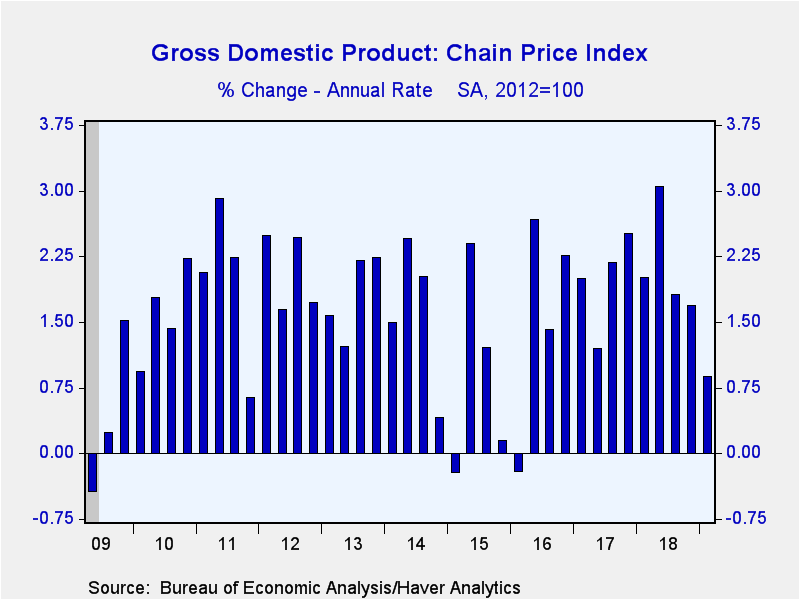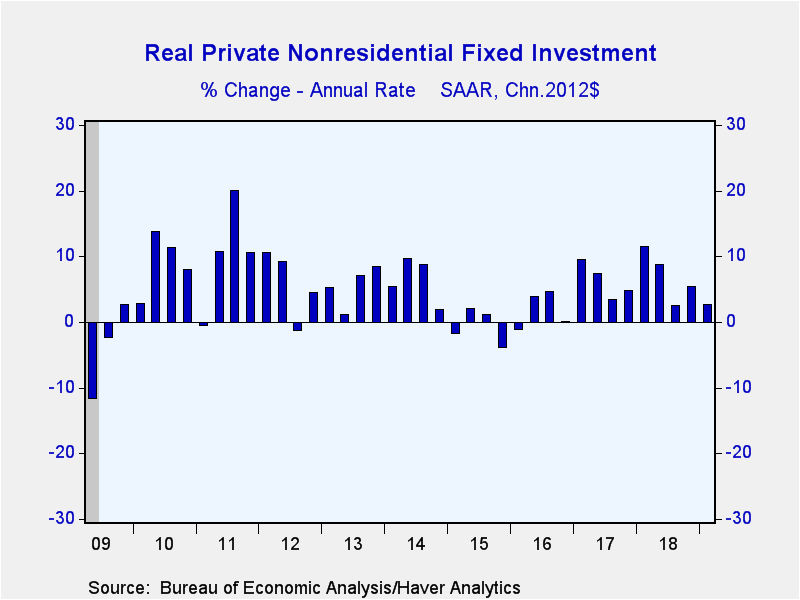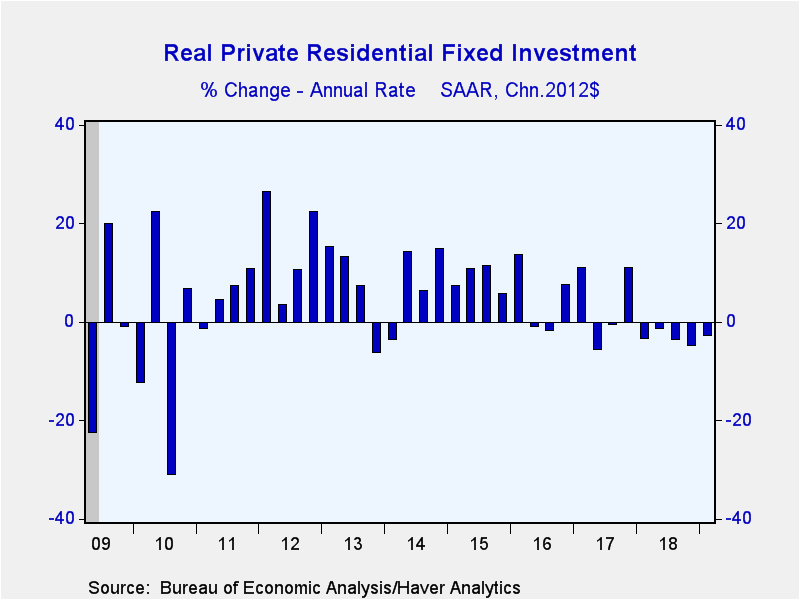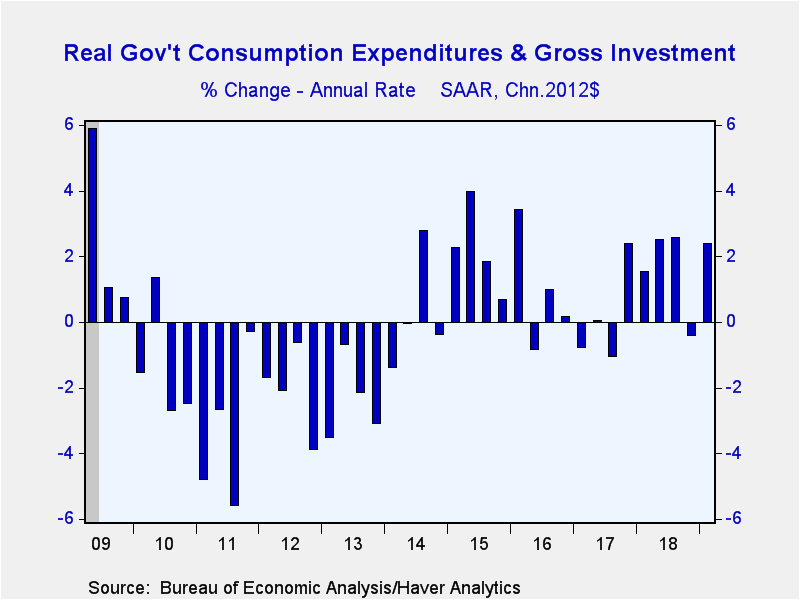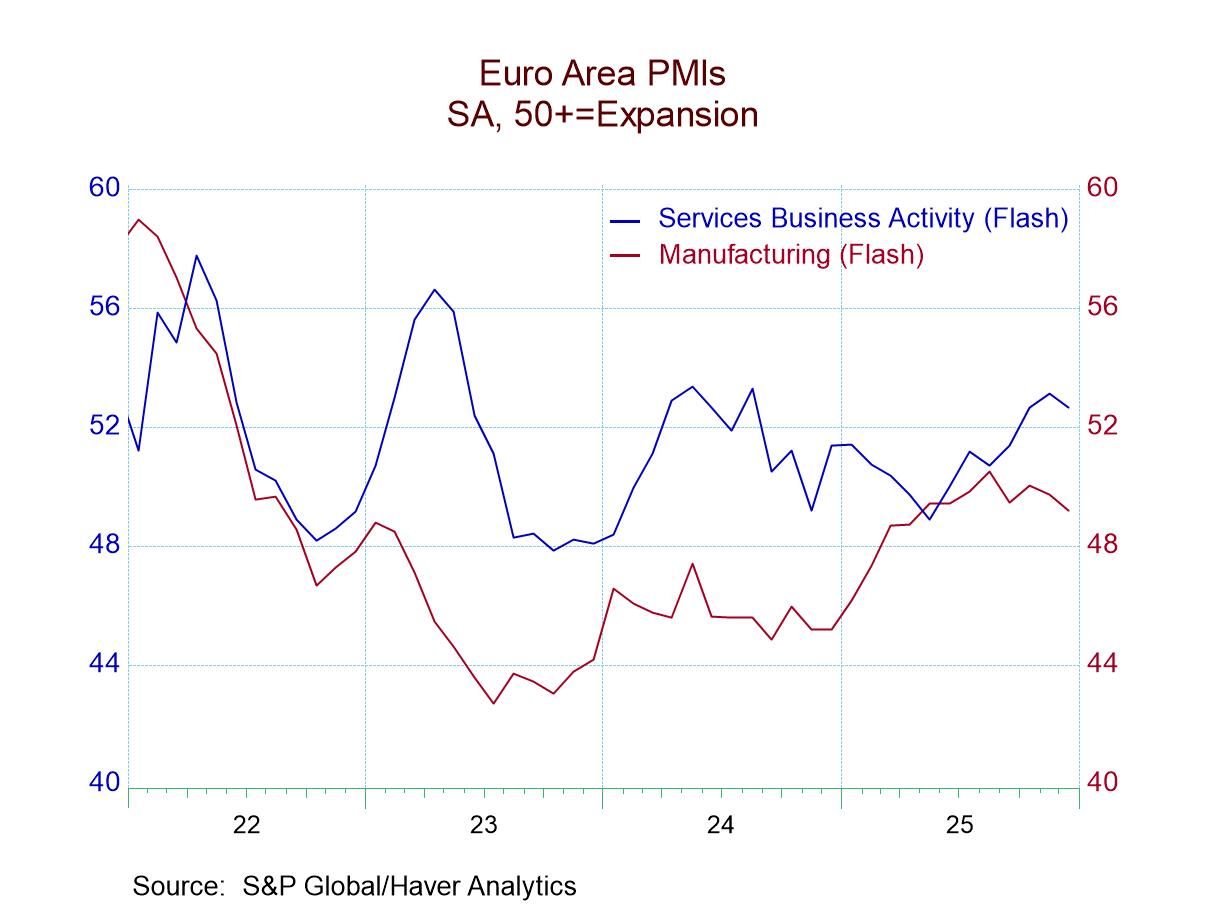 Global| Apr 26 2019
Global| Apr 26 2019U.S. GDP Growth Unexpectedly Accelerates as Price Gains Slow
by:Tom Moeller
|in:Economy in Brief
Summary
The economy began 2019 on a firm footing. Gross domestic product, adjusted for price inflation, increased 3.2% during Q1 2019. The gain lifted growth during the last four quarters to 3.2%, the strongest increase since Q2 2015. The [...]
The economy began 2019 on a firm footing. Gross domestic product, adjusted for price inflation, increased 3.2% during Q1 2019. The gain lifted growth during the last four quarters to 3.2%, the strongest increase since Q2 2015. The rise outpaced expectations for a 1.9% rise in the Action Economics Forecast Survey. Stronger inventory investment and a diminished foreign trade deficit fueled growth last quarter.
Inventory investment added 0.7 percentage points to growth last quarter following a 0.1 addition in Q4'18. Improvement in the foreign trade deficit added 1.0 percentage points to growth following two quarters of subtraction. Exports strengthened 3.7% (2.3% y/y), the largest gain since Q2'18, while imports fell 3.7% (+1.6% y/y). Imports declined across most product categories.
Growth in domestic final sales fell to 1.4% (2.6% y/y), the weakest rate of growth since Q4'15. Consumer spending rose 1.2% (2.7% y/y), the weakest rise in a year. A 5.3% decline (+2.5% y/y) in durable goods demand was paced by an 18.4% decline (-1.9% y/y) in motor vehicle & parts sales. Demand for home furnishings & household equipment eased 0.6% (+1.6% y/y), off for the second straight quarter. These declines were offset by a 7.3% increase (7.0% y) in sales of recreational goods & vehicles. Nondurable product sales increased 1.7% (3.1% y/y). The rise centered in the "other" category as apparel & shoes demand fell 5.6% (+3.7% y/y). Food & restaurant sales fell 2.0% (+1.2% y/y) and demand for gasoline & oil eased 0.3% (+0.9% y/y). Demand for services increased 2.0% (2.7% y/y) as transportation sales surged 6.3% (1.5% y/y) and demand for financial services & insurance strengthened 4.5% (2.3% y/y). Health care demand also rose a strong 3.8% (2.7% y/y) and housing & utilities purchases rose 1.3% (1.6% y/y). Offsetting these increases was a 2.6% decline (+0.4% y/y) in the demand for recreation services.
Business fixed investment grew 2.7% (4.8% y/y) after a 5.4% strengthening. Investment in structures eased 0.8% (+1.3% y/y), down for the third straight quarter. Equipment demand rose a weakened 0.2% (3.7% y/y) as an 8.9% decline (+2.1% y/y) in "other" equipment offset gains everywhere else. Investment in intellectual property products surged 8.6% (8.9% y/y). Transportation equipment demand strengthened 7.2% (5.2% y/y); industrial equipment sales improved 1.1% (3.1% y/y) and information processing equipment sales rose 0.9% (3.8% y/y).
Holding back the gain in overall demand was a 2.8% decline (-3.1% y/y) in residential investment, which has been declining since its peak in Q4'17.
Government expenditures grew at an improved 2.4% rate (1.8% y/y). State & local government spending growth of 3.9% (1.6% y/y) was accompanied by a 0.1% easing (+2.0% y/y) in federal government expenditures. A 4.1% jump (5.3% y/y) in defense spending offset a 6.0% decline (-2.6% y/y) in nondefense outlays.
The GDP price index increased 0.9% (1.9% y/y), the weakest rise in three years. It compared to a 1.2% expected gain. The PCE chain price index increase of 0.6% (1.4% y/y) was underpinned by a 1.3% rise (1.7% y/y) in the index excluding food & energy. The business fixed investment price index rose 1.3% (1.5% y/y) and the residential price index gained 1.8% (3.8% y/y. The government spending price index increased 1.1% (2.4% y/y).
The GDP figures can be found in Haver's USECON and USNA database. USNA contains virtually all of the Bureau of Economic Analysis' detail in the national accounts. Both databases include tables of the newly published not seasonally adjusted data. The Action Economics consensus estimates can be found in AS1REPNA.
| Chained 2012 $ (%, AR) | Q1'19 (Advance Estimate) | Q4'18 | Q3'18 | Q1'19 Y/Y | 2018 | 2017 | 2016 |
|---|---|---|---|---|---|---|---|
| Gross Domestic Product | 3.2 | 2.2 | 3.4 | 3.2 | 2.9 | 2.2 | 1.6 |
| Inventory Effect (%-point) | 0.7 | 0.1 | 2.3 | 0.5 | 0.1 | 0.0 | -0.5 |
| Final Sales | 2.5 | 2.1 | 1.0 | 2.7 | 2.7 | 2.2 | 2.1 |
| Foreign Trade Effect (%-point) | 1.0 | -0.1 | -2.0 | 0.1 | -0.2 | -0.3 | -0.3 |
| Domestic Final Sales | 1.4 | 2.1 | 2.9 | 2.6 | 2.9 | 2.5 | 2.3 |
| Personal Consumption Expenditure | 1.2 | 2.5 | 3.5 | 2.7 | 2.6 | 2.5 | 2.7 |
| Nonresidential Fixed Investment | 2.7 | 5.4 | 2.5 | 4.8 | 6.9 | 5.3 | 0.5 |
| Residential Investment | -2.8 | -4.7 | -3.5 | -3.1 | -0.3 | 3.3 | 6.5 |
| Government Spending | 2.4 | -0.4 | 2.6 | 1.8 | 1.5 | -0.1 | 1.4 |
| Chain-Type Price Index | |||||||
| GDP | 0.9 | 1.7 | 1.8 | 1.9 | 2.2 | 1.9 | 1.1 |
| Personal Consumption Expenditure | 0.6 | 1.5 | 1.6 | 1.4 | 2.0 | 1.8 | 1.1 |
| Nonresidential Investment | 1.3 | 1.1 | 1.6 | 1.5 | 1.2 | 0.7 | -0.8 |
| Residential Investment | 1.8 | 2.6 | 3.6 | 3.8 | 5.6 | 4.5 | 3.6 |
Tom Moeller
AuthorMore in Author Profile »Prior to joining Haver Analytics in 2000, Mr. Moeller worked as the Economist at Chancellor Capital Management from 1985 to 1999. There, he developed comprehensive economic forecasts and interpreted economic data for equity and fixed income portfolio managers. Also at Chancellor, Mr. Moeller worked as an equity analyst and was responsible for researching and rating companies in the economically sensitive automobile and housing industries for investment in Chancellor’s equity portfolio. Prior to joining Chancellor, Mr. Moeller was an Economist at Citibank from 1979 to 1984. He also analyzed pricing behavior in the metals industry for the Council on Wage and Price Stability in Washington, D.C. In 1999, Mr. Moeller received the award for most accurate forecast from the Forecasters' Club of New York. From 1990 to 1992 he was President of the New York Association for Business Economists. Mr. Moeller earned an M.B.A. in Finance from Fordham University, where he graduated in 1987. He holds a Bachelor of Arts in Economics from George Washington University.



